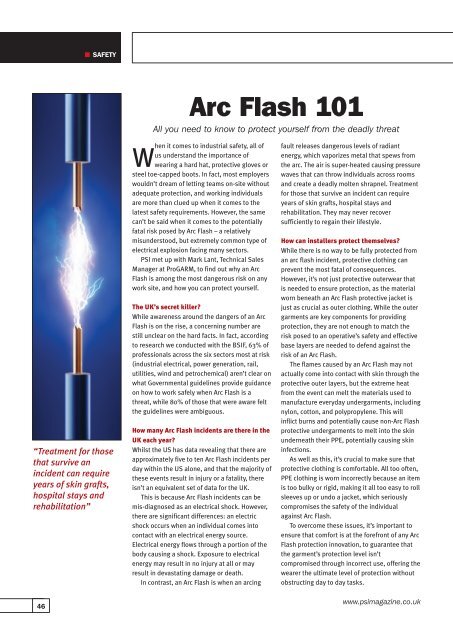PSIJuly2018
You also want an ePaper? Increase the reach of your titles
YUMPU automatically turns print PDFs into web optimized ePapers that Google loves.
SAFETY<br />
Arc Flash 101<br />
All you need to know to protect yourself from the deadly threat<br />
“Treatment for those<br />
that survive an<br />
incident can require<br />
years of skin grafts,<br />
hospital stays and<br />
rehabilitation”<br />
hen it comes to industrial safety, all of<br />
Wus understand the importance of<br />
wearing a hard hat, protective gloves or<br />
steel toe-capped boots. In fact, most employers<br />
wouldn’t dream of letting teams on-site without<br />
adequate protection, and working individuals<br />
are more than clued up when it comes to the<br />
latest safety requirements. However, the same<br />
can’t be said when it comes to the potentially<br />
fatal risk posed by Arc Flash – a relatively<br />
misunderstood, but extremely common type of<br />
electrical explosion facing many sectors.<br />
PSI met up with Mark Lant, Technical Sales<br />
Manager at ProGARM, to find out why an Arc<br />
Flash is among the most dangerous risk on any<br />
work site, and how you can protect yourself.<br />
The UK’s secret killer?<br />
While awareness around the dangers of an Arc<br />
Flash is on the rise, a concerning number are<br />
still unclear on the hard facts. In fact, according<br />
to research we conducted with the BSIF, 63% of<br />
professionals across the six sectors most at risk<br />
(industrial electrical, power generation, rail,<br />
utilities, wind and petrochemical) aren’t clear on<br />
what Governmental guidelines provide guidance<br />
on how to work safely when Arc Flash is a<br />
threat, while 80% of those that were aware felt<br />
the guidelines were ambiguous.<br />
How many Arc Flash incidents are there in the<br />
UK each year?<br />
Whilst the US has data revealing that there are<br />
approximately five to ten Arc Flash incidents per<br />
day within the US alone, and that the majority of<br />
these events result in injury or a fatality, there<br />
isn’t an equivalent set of data for the UK.<br />
This is because Arc Flash incidents can be<br />
mis-diagnosed as an electrical shock. However,<br />
there are significant differences: an electric<br />
shock occurs when an individual comes into<br />
contact with an electrical energy source.<br />
Electrical energy flows through a portion of the<br />
body causing a shock. Exposure to electrical<br />
energy may result in no injury at all or may<br />
result in devastating damage or death.<br />
In contrast, an Arc Flash is when an arcing<br />
fault releases dangerous levels of radiant<br />
energy, which vaporizes metal that spews from<br />
the arc. The air is super-heated causing pressure<br />
waves that can throw individuals across rooms<br />
and create a deadly molten shrapnel. Treatment<br />
for those that survive an incident can require<br />
years of skin grafts, hospital stays and<br />
rehabilitation. They may never recover<br />
sufficiently to regain their lifestyle.<br />
How can installers protect themselves?<br />
While there is no way to be fully protected from<br />
an arc flash incident, protective clothing can<br />
prevent the most fatal of consequences.<br />
However, it’s not just protective outerwear that<br />
is needed to ensure protection, as the material<br />
worn beneath an Arc Flash protective jacket is<br />
just as crucial as outer clothing. While the outer<br />
garments are key components for providing<br />
protection, they are not enough to match the<br />
risk posed to an operative’s safety and effective<br />
base layers are needed to defend against the<br />
risk of an Arc Flash.<br />
The flames caused by an Arc Flash may not<br />
actually come into contact with skin through the<br />
protective outer layers, but the extreme heat<br />
from the event can melt the materials used to<br />
manufacture everyday undergarments, including<br />
nylon, cotton, and polypropylene. This will<br />
inflict burns and potentially cause non-Arc Flash<br />
protective undergarments to melt into the skin<br />
underneath their PPE, potentially causing skin<br />
infections.<br />
As well as this, it’s crucial to make sure that<br />
protective clothing is comfortable. All too often,<br />
PPE clothing is worn incorrectly because an item<br />
is too bulky or rigid, making it all too easy to roll<br />
sleeves up or undo a jacket, which seriously<br />
compromises the safety of the individual<br />
against Arc Flash.<br />
To overcome these issues, it’s important to<br />
ensure that comfort is at the forefront of any Arc<br />
Flash protection innovation, to guarantee that<br />
the garment’s protection level isn’t<br />
compromised through incorrect use, offering the<br />
wearer the ultimate level of protection without<br />
obstructing day to day tasks.<br />
46<br />
www.psimagazine.co.uk

















